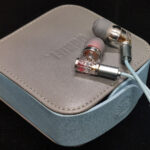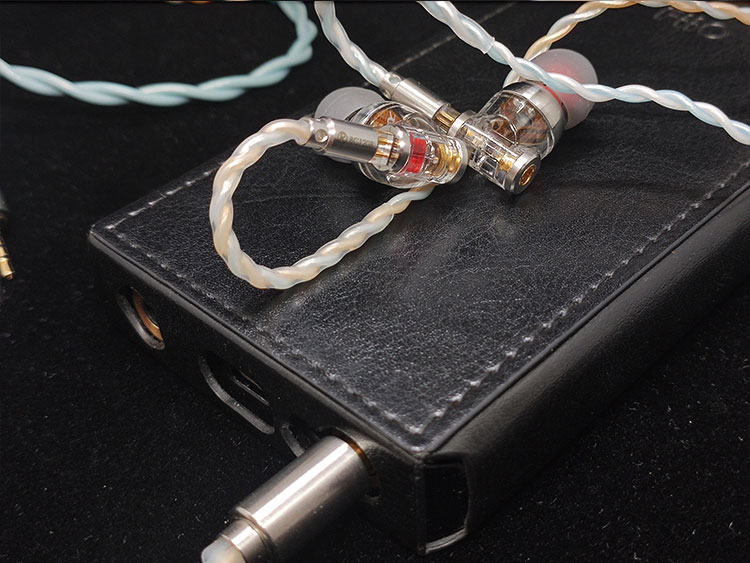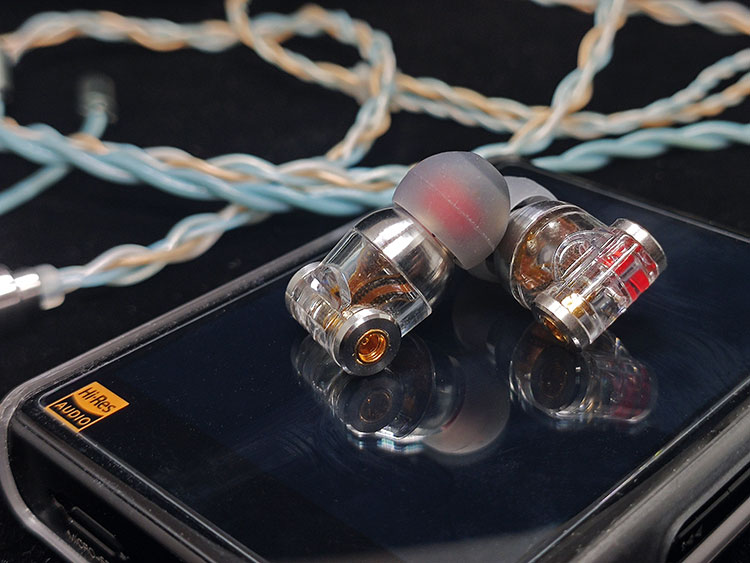The ddHiFi Janus (E2020A) is a single dynamic driver IEM with a unique dual connector design for two styles of wearing. It is priced at $199.99.
Disclaimer: The ddHiFi Janus was sent to us in exchange for our honest opinion in this review. Many thanks to ddHiFi for giving us this opportunity.
You can read about previous ddHiFi products reviewed on Headfonics here.
Note, this 2-page review follows our new scoring guidelines for 2021 which you can read up on here.
ddHiFi is a rather new but innovative brand known for its balanced cable converters, modding parts, and a selection of cool storage options.
Quite unexpectedly ddHiFi released their own IEM, the Janus (E2020A), with a signature transparent housing design that looks quite unconventional. The see-through structure looks absolutely stunning in real life and the build is very industrial with the use of soft FPCB.
Interestingly, this IEM carries both MMCX and 2-pin sockets on the same IEM so you can compare different aftermarket cables on it.
The default package comes with the Forest cable and we are receiving a 4.4mm terminated cable as well. Putting the Janus with some powerful sources, let’s see how it performs!
Design
This is one of the more unique IEMs in the market which allows you to connect to both MMCX and 2-pin terminated cables. The Janus comes in a transparent housing with industrial soft FPCB inside that they claim to enhance the circuitry quality.
The aesthetics are quite a different league from conventional designs and it looks more like a sci-fi item. The injection molding quality is awesome and looks perfectly transparent.
The body of the IEM is curvy, streamlined, and adorned by metallic parts, and you can see all the internal elements through the housing. There are also a lot of fine details such as the L/R engravings on the cable, also a nicely machined y-splitter.
Looking into the clear housing the L/R side comes with different color wirings, red = right side for example, so you can easily figure out which is left and which is right without looking at the other markings.
If you are familiar with ddHiFis converter products it is actually a consistent design language applied on the Janus.
Cables
Stock Cable
The Forest from ddHiFi’s “Air Series” is included with the Janus. The color on the Forest cable is rather unusual and the gauge is thick, so if you don’t slide up the slider and give it a secure fit there may be a tiny bit of microphonics.
The cable is still considered quite flexible, the sheathing material feels very durable and the cable doesn’t get tangled at all. Made from 80 strands of 6N monocrystalline copper (OCC), reinforced with Kevlar fiber sleeving, and comes in a TPE outer sheath, the Forest delivers rich bass performance and sounds overall quite balanced with a good hint of warmth in the midrange.
Upgrade Cable
Aside from the stock cable, you can also purchase the upgrade cable “SKY” BC120B that is crafted with 4×22 strands of silver-plated OCC cores in the colors of red, green, blue, and white.
From official information, the cores are made from high purity 6N silver-plated monocrystalline copper (OCC), insulated with Litz sheathings, and wrapped with TPE outer sleeves.
There are also some fine details in machining the splitter and other metallic parts, which hard to a steampunk-theme. It is visually very appealing as well as offering flexible handling.
The version we have here is the 4.4mm option and it displays a more balanced signature, boosting the mid-treble range slightly compared to the Forest cable and pushes the performance of the Janus further.
Comfort & Isolation
The Janus can be worn straight down plugged in or over the ear. With a rather straightforward design, small profile, and extended nozzle, you can easily get a good seal wearing it either over-ear or straightly inserted.
Isolation is on the weaker side but the vented design empowers the sound output with better air and naturalness.
Overall, comfort is good with a nice fit in the ears. The isolation is strong enough to block noises in a busy coffee shop, but you may need to pump up the volume slightly to cover up some noise from the ambiance.
Packaging & Accessories
The packaging of the Janus and the upgrade cable is kept minimal and consistent with other products they have released. There is an innovative magnetic flip opening design on the carrying case so also their C10B magnetic cable binder clip. The carrying case has an attractive color profile and is very handy as you don’t need to zip and unzip it every time.
In the box, there are S/M/L size tips including sets of “treble” and “bass” tips that have different bore sizes. Depending on your source you may use the bass tips to damp the treble, or using the treble tips which do not alter the bass with its bigger bore.
Sound Impressions
Burn-In
Out of the box with the stock Forest cable, I plugged the Janus straight onto my iPhone and it seems that more power is needed to waken the drivers as well as some time to let the driver settle in, a quick test with the Sky cable swapped sounds flatter and more balanced.
More than 2 weeks of a run-in with various burn-in tracks and white noise was given to the Janus and the cables. After which, there is more control in the bass and the vocal sound less laid back, ready to bring out more details while maintaining a dark background and airy bass.
The Janus is then tested with the Hiby R5S, R6 2020, Shanling M8, M6 Pro, Cowon D3, M11 Pro, Paw Gold, iPhone 6Plus, some other DAPs and amps for the below impressions.
Summary
High gain or power will unleash the full power of the Janus to achieve a better tonal balance and to ensure the low-end weight does not bleed too much for more complex instrumental passages.
The Janus is best matched with sourcess that offers a textured bass response though I recommend the stock treble tips to get a more balanced sound with weaker sources. There is good potential for the Janus to scale up with stronger outputs and it holds up to a higher sound intensity level pretty well.
With a double-vented design, the Janus sounds airy, rich, and full-bodied with a strong sub-bass reach and presence. Very punchy, dense, and weighed. Since it is a rather bass-intensive IEM the Janus pairs better with clean-sounding sources like the HiBy R5S and the M11Pro.
In all pairings, the Janus does not sound offensive at all while achieving a decent body in the vocal, as well as maintaining a good balance between clarity and mid-low presence. Using the SKY upgrade cable there is more treble detail and the bass does sound more controlled.
Bass
The bass is the highlight of the design and Janus’s dynamic driver chucks in an impressive amount of energy to the mid-lows. The punch is powerful, airy, and dense, sounding just right for R&B, club mixes, or anything with strong beats that allow you to immerse in the live setting and tap on your feet.
The driver doesn’t seem to be made from very stiff materials like beryllium or titanium-plated membranes, so it is not offering a pacey attack, but what you get in return is a more fun coloration and expressive bass that fills up the headroom. With the bass decay still being moderately fast bass picking and drumming are very clearly presented, and you can feel good tension in the air.
Depending on the source, the bass can punch quite deep down for example with the more bass-expressive Shanling M8, you can feel the bass presence as low as 30-40hz.
The bass disperses and radiates into mid-air airily when playing Japan Taikos (huge drums), some synthesized bass instruments that reach deep below 40-50hz, with a moderately fast attack down low while being very full and powerful. It also makes live shows very enjoyable and immersive.
There is good synergy with sources that sounds cleaner, for example, the Cowon Plenue D3 and the Hiby R5S which keeps the bass more agile and sounds swifter when it articulates to the mid frequencies, revealing more micro-details in the upper range.
With DAPs that are capable of reproducing the bass with a lot of texture and power, I recommend switching to the highest gain options and this will push the dynamics even further while sounding more balanced in tone.
Mids
The Janus is able to deliver rounded and well-separated vocals from the backing instruments while having a lot of energy in the lows. It holds up quite well in resolution when more elements get thrown into the track.
The mids on the Janus are quite expressive and notably, very smooth, natural, and soothing when matched with the right sources. The area around 200-400Hz is quite rich so there is a good level of thickness and body in the vocals and string instruments.
Hoarse and thinner voices and the upper mids are lifted for clarity but never really gets hot. It sounds expressive and engaging with almost any singer. When powered sufficiently with a clean source it will sound more natural in the mids but when underpowered the dynamic range may be compressed.
For its price, I think the resolution and separation in the mid-bass department are decent, and there are enough dynamics to sound enjoyable for tracks with a high dynamic range.
On more bass-intensive sources the SKY cable will achieve a more linear tuning while equalizing down the mid-low frequencies will also help up the clarity levels. Overall, the midrange performance is quite natural with adequate resolution and energy to present details dynamically.
Treble
While the Janus is quite warm in tuning it doesn’t mean it is lacking in the upper register. Some of the lower treble frequencies around 5kHz are carefully lifted to compensate for the rather bassy tuning. That means snares and high hats have a small bit of crispness to them that keeps the sound relatively snappy.
The higher treble rolls off slowly and is slightly on the shy side. Sibilance is well controlled, as such the mid-range sounds even smoother and warmer in tone but without hampering staging and openness much.
Some of the overtones from guitars and other instruments in the upper mids can still be heard but when it comes to the highest strings on violin or flutes you will hear the treble sounding dimmer.
The bright side of the tuning comes you listen to some older tunes from the 70s and 80s. And yet, there is no sign of sibilance and the slightly V-shaped tuning helps pump up the dynamics to make it very engaging with old JPop and Jazz.
Switching to the “Treble tips” you can hear the bass being slimmed down and more treble detail being revealed,. Depending on your personal sound preference if you want slightly more excitement up top switching to the treble tips could be a worthy try.
Imaging & Staging
The Janus has a forgiving tuning and a rather expanded staging with a slightly fat vocal image. The vocal positioning is a little bit forward, while the instruments are quite nicely spaced without bleeding much into the vocal range. While some of the sparkle is taken away the tuning still retains decent air so you will still hear some good depth and moderately wide staging.
The soundstage being rendered feels like a room-sized presentation. Though limited in the range there is a lot of dynamics and air so it does not sound boxy, working well with chamber music, particularly cello/double bass that stacks together rich and full-sounding bass elements.
There is good magic with DAPs like the Lotoo PAW Gold that is very controlled and rich in bass texture, also delivering delicate treble. With IEMs that have a looser midrange performance or lacking power, the Janus may get less as defined.
Synergy
The Janus has a distinctive character in design and sound. It is easy to achieve a dynamic pairing with a wide range of devices and it is responsive to power. The stock tuning is strong in mid-bass, slightly overwhelming at times. With lower power outputs I personally prefer equalizing down the 200-300Hz range for better clarity, or to pair it with cleaner-sounding DAPs.
With the stock Forest cable, there is good warmth and roundness and it delivers a dense and powerful bass. Switching to the Sky cable the tuning gets flatter and more balanced, now the Janus is able to pick up more details while sounding slightly more expanded in staging, and it works great with decent power.
On desktop amps, you can immediately hear a lot more dynamics and control, and in all cases, the Janus is a good match with pop music and strings. There are good dynamics and a good balance between resolving power and meatiness achieved.
Select Comparisons
Astrotec Volans
$329
Technical
The Astrotec Volans features a single 10.5mm Tesla magnetic brass dynamic driver combined with a multi-layer biological diaphragm.
Both the Volans and the Janus have a single 32Ω dynamic driver down the hood and both of them are expressive in the bass and rounded in the treble. The Volans is more responsive to power while more juice is needed to do the Janus justice. The impression below is made with the SKY cable on the Janus to match the price and tonality.
Performance
With most gear, the Janus displays a more M-shaped signature that pushes out the upper vocal range for clarity. The Janus requires more power to sound as linear and clear in the upper registers when compared to the Volans which is comparatively slimmer in the mids.
The midrange is also more focused in positioning on the Volans and placed slightly more far off than on the Janus. This helps the Volans to sound more open on portable sources.
However, If you love to use your strong amplifier or desktop sources to listen to your IEMs, then Janus will have an advantage in delivering meatier mid-bass and more intimate mids. The bass in Janus also goes a little bit deeper and the rumble in explosion scenes can be heard more clearly.
Regarding isolation, the Volans is a step above due to the fact that the Janus is more vented. There is however, more air and punchiness achieved but noise squeezes in and affects clarity when ambient noises get loud.
Despite this fact, the midrange is smooth and creamy, more punchy and snappy than the majority of IEMs when sufficiently powered and it doesn’t sound boxed for indoor use.
That being said, if you possess strong outputs and portable amps, the Janus has more potential to be able to scale better a bit more with higher gain and power. The Volans is more sensitive and you can easily get a good pairing with even lower-end DAPs.
Shanling ME700 lite
$499
Bass
The Shanling ME700 has got a new little brother ME700, which inherits the strong midrange performance and a 5-driver design with a stiff Titanium dynamic driver. The bass is agile, able to keep up with the faster BA drivers while delivering solid bass punches.
Compared to the Janus, the Me700 can be easily powered and has a more “modern” tuning and faster attack, focusing on extracting more details and bringing out more clarity. The Janus on the other hand has slower bass decay and the top end is more rounded. Surprisingly, the dynamic range is quite comparable to the ME700 when driven by higher-end sources.
Mids
The ME700 is not as mid-bass intensive as the Janus, but there is still some warmth in the midrange to color the vocals more naturally. The bass does not go as deep but the treble is clearly more capable and stronger in presence.
Treble
The Janus is less energetic in the treble range and not as dense in the mids but there is nothing to blame looking at its price and configuration. If your source has textured bass the Janus could make a more engaging and swift pairing that makes live recordings heart pounding and feet tapping.
Overall
Much like the Volans, the ME700 lite is easier to drive and achieves better linearity, dynamics even with sources that are not too strong in power. The vocal is nicely polished with 4 BA drivers inside and it is able to capture more micro details and density in the upper mids.
The Janus clearly has a different tuning focus and sounds softer and rounded in the treble. It will require more decoding and amping power to shine and to sound as refined.
It depends on whether you want more micro details or a more dynamic presentation. Personally, I think both complement each other rather than compete.
Our Verdict
The Janus is one of the most uniquely designed IEMs I have seen this season. The tuning approach is also quite different from the competition, especially the airy mid-lows performance that gives good authority to drummings and bass guitars.
It is a good challenge to different sources to check how much bass texture and power is present, while the dual-socket design allows you to compare aftermarket cables with different termination.
This is a fun and engaging IEM that fuses a very different design and an engaging tuning, unexpectedly BIG in the bass with a rather small form factor. I am looking forward to seeing what innovative designs ddHiFi will bring next!
ddHiFi Janus SPecifications
- Cable connector MMCX
- Plug termination 2.5mm
- Impedance 32ohms
- Sensitivity 97dB/mW
- Frequency Range 20-20000Hz
- Cable length 1.2m











